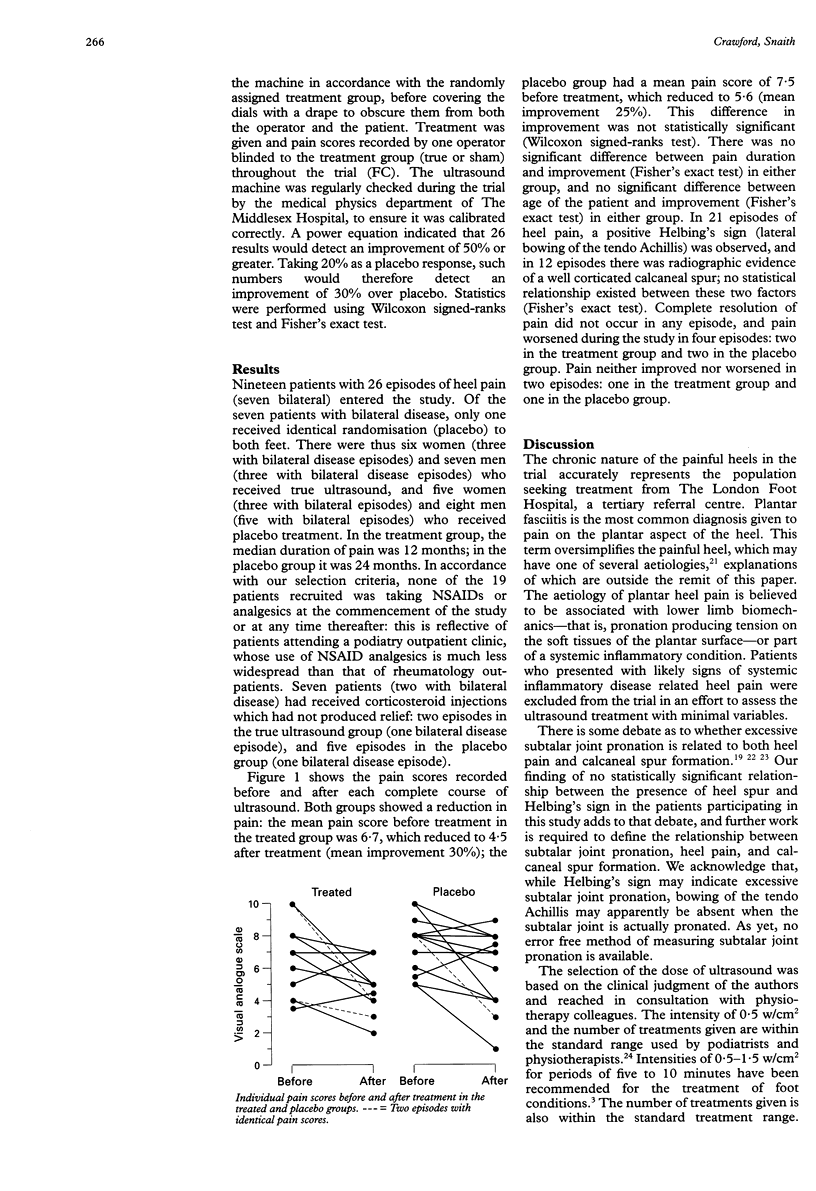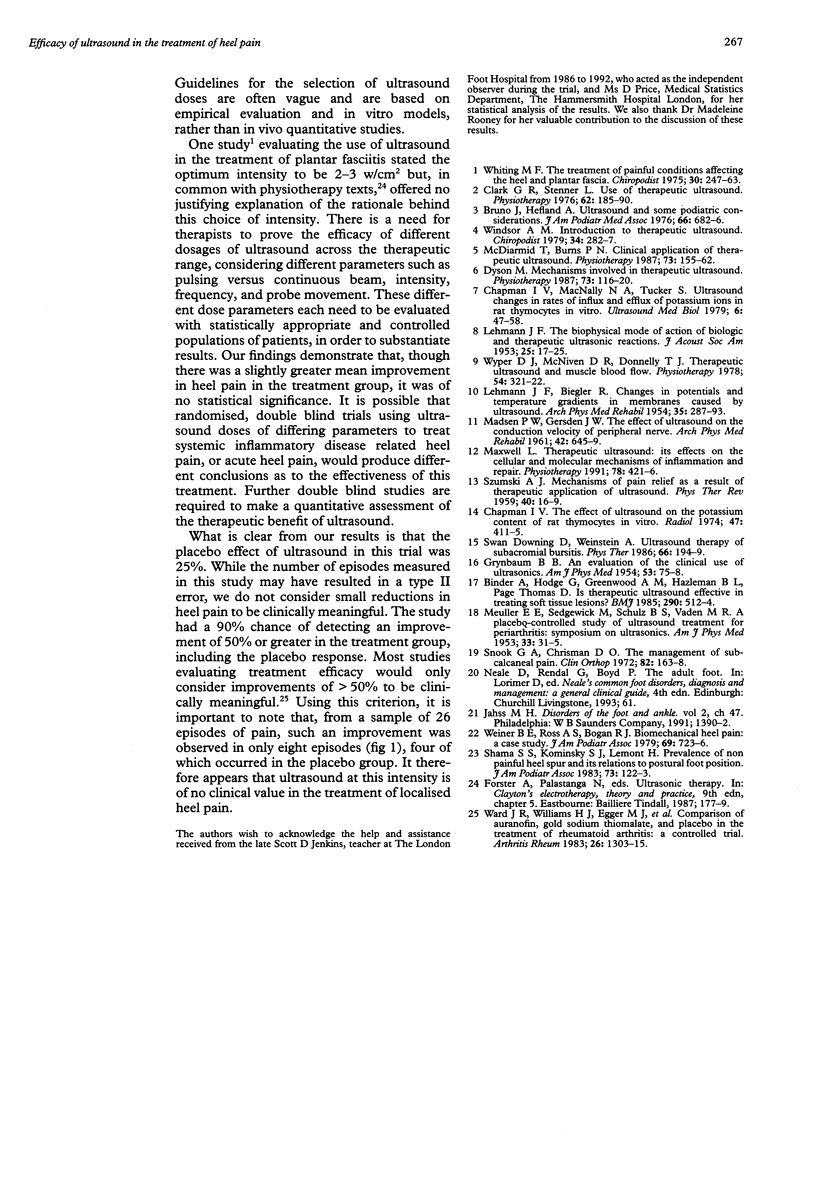Abstract
OBJECTIVES: To evaluate the therapeutic effect from ultrasound in the treatment of plantar heel pain by physiotherapists and podiatrists, and to quantify the placebo effect of this electrophysical agent. METHODS: Patients experiencing episodes of plantar heel pain were allocated randomly, at each episode, to receive either true ultrasound (machine calibrated to deliver a dose of ultrasound at 0.5 w/cm2, 3 MHz, pulsed 1:4), for eight minutes, or sham ultrasound (only the timer on the machine activated). Each episode was treated, according to randomisation, eight times. An independent observer set the equipment before obscuring the control panel with a drape. All treatments were undertaken by the same operator. Patients' pain scores were measured on a 10 cm linear analogue scale before the course of eight treatments commenced and at the end of the course, and analysed using a Wilcoxon Signed-Ranks test. RESULTS: Nineteen patients experienced episodes of heel pain (seven bilateral). Both groups showed a reduction in pain; the improvement was 30% in the treated group and 25% in the placebo group (p = 0.5). CONCLUSIONS: Therapeutic ultrasound at a dosage of 0.5 w/cm2, 3 MHz, pulsed 1:4, for eight minutes is no more effective than placebo in the treatment of plantar heel pain.
Full text
PDF


Selected References
These references are in PubMed. This may not be the complete list of references from this article.
- Binder A., Hodge G., Greenwood A. M., Hazleman B. L., Page Thomas D. P. Is therapeutic ultrasound effective in treating soft tissue lesions? Br Med J (Clin Res Ed) 1985 Feb 16;290(6467):512–514. doi: 10.1136/bmj.290.6467.512. [DOI] [PMC free article] [PubMed] [Google Scholar]
- Bruno J., Helfand A. E. Ultrasound and some podiatric considerations. J Am Podiatry Assoc. 1976 Sep;66(9):682–686. doi: 10.7547/87507315-66-9-682. [DOI] [PubMed] [Google Scholar]
- Chapman I. V., MacNally N. A., Tucker S. Ultrasound-induced changes in rates of influx and efflux of potassium ions in rat thymocytes in vitro. Ultrasound Med Biol. 1980;6(1):47–58. doi: 10.1016/0301-5629(80)90063-0. [DOI] [PubMed] [Google Scholar]
- Chapman I. V. The effect of ultrasound on the potassium content of rat thymocytes in vitro. Br J Radiol. 1974 Jul;47(559):411–415. doi: 10.1259/0007-1285-47-559-411. [DOI] [PubMed] [Google Scholar]
- Downing D. S., Weinstein A. Ultrasound therapy of subacromial bursitis. A double blind trial. Phys Ther. 1986 Feb;66(2):194–199. doi: 10.1093/ptj/66.2.194. [DOI] [PubMed] [Google Scholar]
- GRYNBAUM B. B. An evaluation of the clinical use of ultrasonics. Am J Phys Med. 1954 Feb;33(1):75–78. [PubMed] [Google Scholar]
- LEHMANN J. F., BIEGLER R. Changes of potentials and temperature gradients in membranes caused by ultrasound. Arch Phys Med Rehabil. 1954 May;35(5):287–295. [PubMed] [Google Scholar]
- MADSEN P. W., Jr, GERSTEN J. W. The effect of ultrasound on conduction velocity of peripheral nerve. Arch Phys Med Rehabil. 1961 Sep;42:645–649. [PubMed] [Google Scholar]
- Snook G. A., Chrisman O. D. The management of subcalcaneal pain. Clin Orthop Relat Res. 1972 Jan-Feb;82:163–168. [PubMed] [Google Scholar]
- Ward J. R., Williams H. J., Egger M. J., Reading J. C., Boyce E., Altz-Smith M., Samuelson C. O., Jr, Willkens R. F., Solsky M. A., Hayes S. P. Comparison of auranofin, gold sodium thiomalate, and placebo in the treatment of rheumatoid arthritis. A controlled clinical trial. Arthritis Rheum. 1983 Nov;26(11):1303–1315. doi: 10.1002/art.1780261102. [DOI] [PubMed] [Google Scholar]


